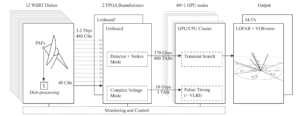Raw, down-sampled pointings
The time-domain data are in PSRFITS format, with 1-bit sampling. The data are total intensity (Stokes I). For each pointing, all TABs are available. Data from before 2020 May 1 supply 384 channels of 0.8MHz each, with a time resolution instead of 2.048ms. Later data are archived using higher temporal and spectral resolution, and provide 768 channels of 0.4MHz each, every 0.8ms.
Where to find the data
The Apertif Time-Domain Data Release 1 (ARTS DR1) is hosted on the Apertif Long Term Archive and exposed to the community through the standard Virtual Observatory protocol. This section describes how the data products can be queried and accessed by using different applications.
User Interfaces
The science-ready data products are exposed through standard Virtual Observatory (VO) protocols to facilitate their access and exploration.
The Apertif Time-Domain DR1 data is hosted on the Apertif Long Term Archive (ALTA) system. We recommend astronomers to use the VO interfaces for data discovery. These interfaces will redirect to ALTA file servers for data access where appropriate.
The data published in the VO can also be accessed using a web browser at https://vo.astron.nl (how to access the data and the relevant explanation about various data services can be found here).
Data Usage Policy
Papers making use of this data should include the following acknowledgement:
This work makes use of data from the Apertif system installed at the Westerbork Synthesis Radio Telescope owned by ASTRON. ASTRON, the Netherlands Institute for Radio Astronomy, is an institute of the Dutch Research Council (“De Nederlandse Organisatie voor Wetenschappelijk Onderzoek, NWO).
In addition, they should cite the time-domain overview paper:
van Leeuwen, J. et al. “The Apertif Radio Transient System (ARTS): Design, Commissioning, Data Release, and Detection of the first 5 Fast Radio Bursts”, 2023, A&A


